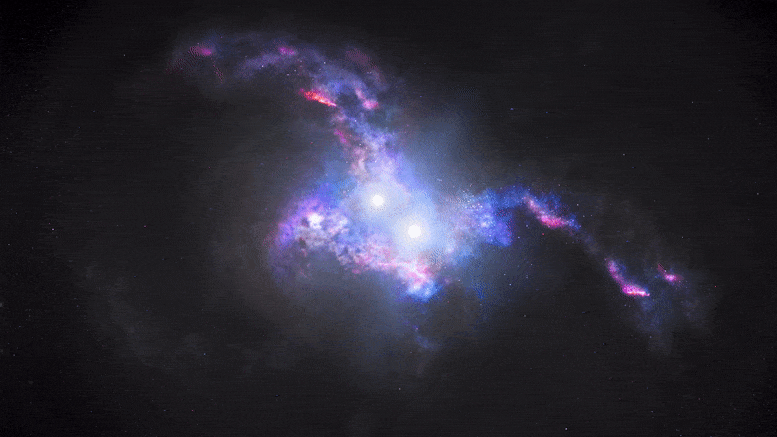
These giant blazing light bulbs are a pair of quasars, brought to life by the collision of our Milky Way with the neighboring Andromeda galaxy.
Quasars are ignited by monster black holes voraciously feeding on infalling matter, unleashing a torrent of radiation.The four galaxies, each containing a central, bright quasar, are in the process of merging.
As the two galaxies in each quasar pair move closer together, so do their quasars.
Hubble caught the action, photographing two quasar pairs that existed 10 billion years ago, during the peak epoch of galaxy close encounters.
These two Hubble Space Telescope images reveal two pairs of quasars that existed 10 billion years ago and reside at the hearts of merging galaxies.NASA’s Hubble Space Telescope is “seeing double.” Peering back 10 billion years into the universe’s past, Hubble astronomers found a pair of quasars that are so close to each other they look like a single object in ground-based telescopic photos, but not in Hubble’s crisp view.The researchers believe the quasars are very close to each other because they reside in the cores of two merging galaxies.“We estimate that in the distant universe, for every 1,000 quasars, there is one double quasar.The discovery of these four quasars offers a new way to probe collisions among galaxies and the merging of supermassive black holes in the early universe, researchers say.There were a lot of galaxy mergers back then feeding the black holes.
“This truly is the first sample of dual quasars at the peak epoch of galaxy formation with which we can use to probe ideas about how supermassive black holes come together to eventually form a binary,” said research team member Nadia Zakamska of Johns Hopkins University in Baltimore, Maryland.This artist’s conception shows the brilliant light of two quasars residing in the cores of two galaxies that are in the chaotic process of merging.In a few tens of millions of years, the black holes and their galaxies will merge, and so will the quasar pair, forming an even more massive black hole.
Shen and Zakamska are members of a team that is using Hubble, the European Space Agency’s Gaia space observatory, and the Sloan Digital Sky Survey, as well as several ground-based telescopes, to compile a robust census of quasar pairs in the early universe.As two close galaxies begin to distort each other gravitationally, their interaction funnels material into their respective black holes, igniting their quasars.
“Finding dual quasars at this early epoch is important because we can now test our long-standing ideas of how black holes and their host galaxies evolve together.”.
Astronomers have discovered more than 100 double quasars in merging galaxies so far.The pairs of host galaxies will eventually merge, and then the quasars also will coalesce, resulting in an even more massive, single solitary black hole.The quasars aren’t moving through space in any measurable way, but instead their jiggle could be evidence of random fluctuations of light as each member of the quasar pair varies in brightness.Quasars flicker in brightness on timescales of days to months, depending on their black hole’s feeding schedule.
When the first four targets were observed with Hubble, its crisp vision revealed that two of the targets are two close pairs of quasars.Team member Xin Liu of the University of Illinois at Urbana-Champaign called the Hubble confirmation a “happy surprise.” She has long hunted for double quasars closer to Earth using different techniques with ground-based telescopes.Their Nature Astronomy article is a “proof of concept that really demonstrates that our targeted search for dual quasars is very efficient,” said team member Hsiang-Chih Hwang, a graduate student at Johns Hopkins University and the principal investigator of the Hubble program.Although the team is convinced of their result, they say there is a slight chance that the Hubble snapshots captured double images of the same quasar, an illusion caused by gravitational lensing.However, the researchers think this scenario is highly unlikely because Hubble did not detect any foreground galaxies near the two quasar pairs.
One example is NGC 6240, a nearby system of merging galaxies that has two and possibly even three supermassive black holes.
The galactic tussle would likely feed the supermassive black holes in the core of each galaxy, igniting them as quasars.
Reference: “A hidden population of high-redshift double quasars unveiled by astrometry” by Yue Shen, Yu-Ching Chen, Hsiang-Chih Hwang, Xin Liu, Nadia Zakamska, Masamune Oguri, Jennifer I-Hsiu Li, Joseph Lazio and Peter Breiding, 1 April 2021, Nature Astronomy.